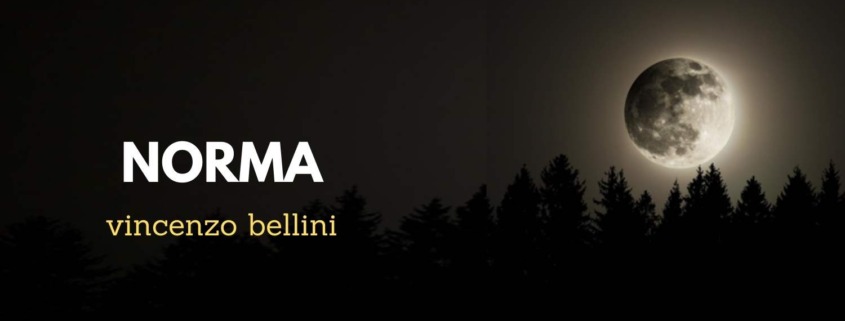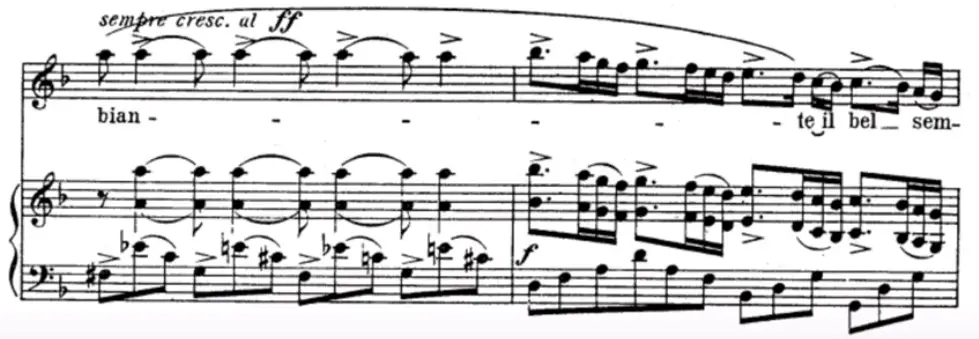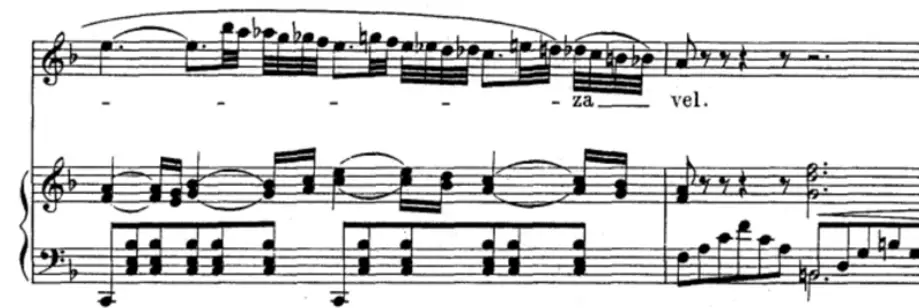CASTA DIVA – an aria from the opera Norma
The online guide to Bellini’s aria CASTA DIVA
Read Interesting facts and hear great YouTube Videos about the famous Aria “CASTA DIVA”.
If you want to hear more about the opera NORMA, click on the link to the opera portrait
The aria – synopsis and background
Synopsis: In the sacred forest of the gallic druids. A holy ceremony is in progress. The visionary Norma will cut the holy mistletoes tonight and announce the will of the god Irminsul. The druids hope that the oracle will prophesy a revolt against the Roman occupying power. Norma secretly conceived two children with the proconsul of the Romans , and thus broke her vow of chastity as a priestess. She cuts the mistletoe. At full moon Norma begs the chaste moon goddess for peace.
The aria is set in a moonlit night. Bellini’s orchestral accompaniment is simple, each word is understandable by the restraint of the orchestration and gives a dramatic meaning to the text and thus to the ritual of the druids.
The aria was written in close collaboration with Giuditta Pasta, the singer of the premiere. Bellini is said to have written no less than nine sketches. With Pasta he had already developed the role of Amina in “La sonnambula”. Bellini originally wrote the aria in G major. But Pasta wanted it a little deeper. Since then it has generally been sung in the F major variant (i.e. one note lower).
Bellini has written an accompaniment with a fixed pattern. A waving 12/8 bar allows the singing voice the freedom of the rubato, the voice floats above the orchestra and the singer can thus give the aria her own character. Verdi spoke of the “long melody” of Bellini. It is known that Bellini’s style inspired Chopin. Many of his nocturnes are written exactly in this way.
It only takes one bar of introduction and the listener is in a moonlit night. Next to the strings we hear a flute that exposes the melody. The singer sings the long melody with broad legato. She has to conjure up the intimacy of the scene in pianissimo.
A first highlight comes after 10 bars with a multiple repeated A:
Repeated ornaments complete the first part.
The first part repeats itself, but gains intensity, a dramatic high Bflat introduces the conclusion of this part. The following A’s of the libretto are often sung an octave higher than written in order to increase the drama of the scene with stronger leaps.
A broad ornamentation introduces the quiet end of this beautiful aria.
Casta Diva became one of the greatest and most important arias of the Belcanto. The combination of a broad crescendo and a melody constantly increasing in pitch moves the listener and, together with the magic of the moon night, results in a harmonious and gripping tone painting.
The Aria – the text of CASTA DIVA
Praise also goes to the lyricist Romani, who found inspiring words for this aria. Romani was the most sought-after librettist of his time. He was 15 years his senior, and Bellini developed a friendship at an early age that was conducive to collaboration. Romani wrote a total of seven opera libretti for Bellini over a six-year period, making him an important literary reference for the precocious and productive composer.
Casta Diva, che inargenti
Queste sacre antiche piante
A noi volgi il bel sembiante
Senza nube e senza vel
Tempra, o Diva
Tempra tu de cori ardenti
Tempra ancora lo zelo audace
Spargi in terra quella pace
Che regnar tu fai nel ciel.
Fine al rito, e il sacro bosco
Sia disgombro dai profani
Quando il Nume irato e fosco
Chiegga il sangue dei Romani
Dal Druidico delubro
La mia voce tuoner
Cadr punirlo io posso
Ma, punirlo, il cor non sa
Ah! bello a me ritorna
Del fido amor primiero…
Chaste Goddess, who inargues
These sacred ancient plants
To us turn the beautiful semblance
Without cloud and without veil
Temper, O Diva
Tempra tu de cori ardenti
Temper again the bold zeal
Scatter on earth that peace
That you make reign in heaven.The rite is over, and the sacred forest
Be cleared of the profane
When the angry and gloomy Nume
Demands the blood of Romans
From the Druidic delubrium
My voice will thunder
I can fall and punish him
But the heart does not know how to punish
Ah! beautiful to me returns
Of the first faithful love…
Written for a dramatic coloratura soprano
The role of Norma is written for a dramatic coloratura soprano. The dramatic coloratura soprano must have both coloratura ability and the ability to master dramatic expression with a larger vocal volume. If this voice can also sing lyrical parts, so it can happen that the “dramatic coloratura soprano” can sing a wide repertoire.
Famous interpretations of CASTA DIVA
The first interpretation is from Maria Callas recording with the conductor Votto (a live recording). Norma was the opera she sang the most. Of her approximately 500 opera performances, 89 were dedicated to Norma. “Casta Diva” was her signature aria. She forms the cantilena expressively and flooded, and the high B flat is beautifully sung. There is hardly an aria in the professional world where there is such unanimous agreement as to who delivered the best interpretations as in this piece.
Casta Diva – Callas
The greatest Norma after the time of Callas was probably Joan Sutherland. She was the first to rediscover the original key and sang the aria in the one tone higher in G major.
Casta Diva – Sutherland
Sonya Yoncheva dared to take on the role in 2016, after Anna Netrebko finally abstained from singing the role in a Convent Garden production. She convinced in this difficult role. She makes this prayer a dreamy cantilena.
Casta Diva – Yoncheva
The conditions of Montserrat Caballé for the role of Norma were not ideal. On the one hand, the experts did not attribute her the singing technique of a Sutherlandes or Callas for the coloratura, and on the other hand, the role was too heavy for her, being a lyrical soprano. Her qualities were the flooding tones and the high pianissimi. Nevertheless, Caballé declared that her Norma 1974 was the greatest achievement of her career.
Casta Diva – Caballé
According to Tullio Serafin, Rosa Ponselle was one of the three “wonders of the world” along with Enrico Caruso and Tita Ruffo. Kesting: “the flow of the voice, the bright luminosity of the voice, the suppleness of the melisms are of intoxicating beauty”. She sings the aria in this recording without repetition.
Casta Diva – Ponselle
The charm of Anita Cerquetti’s recording is hard to resist. Her voice has a “hoarse” intensity. She became famous when she replaced Maria Callas in 1958. She had to step in as Norma in Rome only two days after a Norma performance in Naples. In that month, the 27-year-old sang this role alternately in Rome and Naples. 3 years later she got vocal difficulties and had to end her operatic carreer. Probably because of overloading the voice.
Casta Diva – Cerquetti
We also hear a recording of Leyla Gencer. Her vocal performance is incredibly dramatic and moving. The turk Gencer was Callas’ contemporary and a renowned specialist in the belcanto repertoire. Sadly she was largely ignored by the recording industry.
Casta Diva – Gencer
Finally, Netrebko’s interpretation must not be missing. Too bad she didn’t sing Norma on stage!
Casta Diva – Netrebko
Peter Lutz, opera-inside, the online opera guide to the aria “CASTA DIVA” from the opera Norma from Vincenzo Bellini.










Exceptional! Thank you very much!